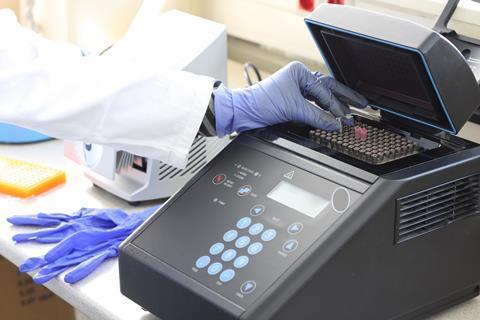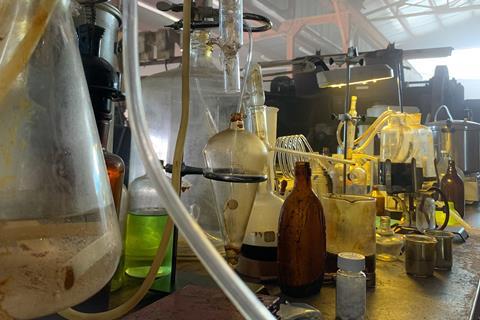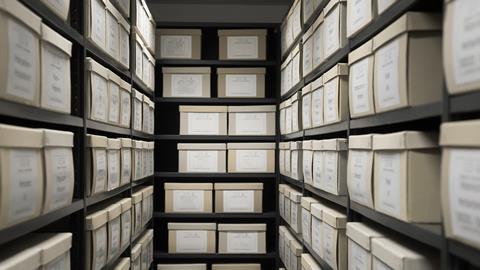Investigate the tools and techniques forensic chemists use to solve abandoned criminal cases
In 1994, a body was found floating in the North Sea, off the coast of Germany. Aged somewhere between 45 and 50, the corpse was tall and had been fatally injured before his death. To this day, his identity remains a mystery – he’s known only as The Gentleman or North Sea Man. It’s one of the cold cases that forensic chemists are trying to crack.
‘There are over 1000 unidentified bodies and remains in the UK,’ explains Rachel Bolton-King, an associate professor in forensic science at Staffordshire University. The university is working with German police on identifying The Gentleman through DNA analysis. ‘But in cold cases, we’re able to apply some of the most innovative methods in forensic science.’
‘We are about the tiniest particles – visualising them and detecting them,’ says Rachel. ‘It could be paint fragments, glass fragments, fibres, gunshot residue, as well as things that you can physically see. It could be paper impregnated with drugs, or [drugs] seized in bulk at borders.’
‘We are the detectives of chemistry,’ agrees Raychelle Burks, associate professor of analytical chemistry at American University, Washington DC. ‘We don’t make things – we find them.’
In your class
Reinforce curriculum-based learning about analytical chemistry by discussing the techniques used to help solve crimes, both past and present. Give learners the opportunity to apply what they have learned about separation techniques and chemical tests to the unfamiliar context of a crime scene to check understanding and link learning to future careers.
Chemical detectives

There are a vast number of tools available to a forensic specialist. They can be as simple as dusting for fingerprints, to detecting blood using luminol (C8H7N3O2) – which reacts with iron in haemoglobin and glows in the presence of an oxidising agent – to analytical methods such as Raman spectroscopy, determining the vibrational spectra of molecules. The technology of forensics has been changing rapidly for decades. ‘Technology that would have been lab-bound 10 years ago hasn’t just improved its limits of detection,’ Raychelle says. ‘Now it’s not even just portable, it’s handheld! It’s this kind of analytical prowess in the field that can help make decisions more data-driven.’
This has a huge potential impact on fieldwork. ‘Say you’ve got a mysterious package or luggage that’s been left somewhere, or an area that’s been exposed to a nerve agent,’ Raychelle relays. ‘We just put our handheld device up to the container and read the sample. I grew up watching Star Trek and now we can do that! These devices can be helpful if you have a crime scene like a clandestine laboratory, where you need to make sure it’s safe before you start work.’
X-ray fluorescence can be used to produce visual chemical maps of each element
‘We don’t even have to sample from surfaces anymore,’ Rachel adds. ‘We now have analytical techniques that enable you to look through material that’s been painted over or covered in blood to see if gunshot residue might be present. We can even determine the sequence if multiple shots have been fired. X-ray fluorescence [a technique that bombards materials with X-rays or gamma rays, causing it to give off its own, characteristic X-rays in response] can be used to produce visual chemical maps of each element.’
It’s this rapid advance that’s cracking cold cases wide open: we now have access to techniques that previous generations never did.
Investigation adjacent

Yet, while technology is important, in forensics it works in tandem with old-fashioned investigation. The case of The Gentleman is a great example. Previously, the best clues as to the dead man’s origins were that his clothes were from the UK brand Marks & Spencer, and his corpse had been weighed down by cast iron from a cobbler’s in Bristol. However, last year forensic scientists at Murdoch University in Australia used isotopic ratio analysis to analyse The Gentleman’s bones. Where you live, the weather you experience, food you eat and drink and even the dust you breathe can alter the chemical composition of your bones. The conclusion was that The Gentleman was either from Australia or had spent a significant portion of his life there. While The Gentleman’s name remains elusive, investigators are now one step nearer to unravelling the mystery man’s identity.
‘There are other cases where people have been looking at soil traces on clothing,’ says Rachel, ‘and we’ve been able to analyse them and detect what kind of soil it may have come from and therefore where that body might have been. Or there might be decomposition and only parts of their clothing are left. We could use an analytical technique, like polarised light microscopy and infrared spectroscopy, to look at those materials. What are they made of?’ From there, it’s up to detectives to work out how the body got there.
It’s only for really serious crimes and more complicated scenes that forensic scientists are called out
This kind of chemical footprint is used in other types of crime, too – such as tracking down the origins of illegal drugs. ‘Cooks are very particular in the method they use,’ Raychelle says. ‘You can look at their reagents, their adulterants, cutting agents, things like that … you can put all that information together and find someone producing a product with a unique chemical signature. Then you can go deeper: you can use isotope ratios to say, “OK, where in the world does the water supply look like this?” or “Where is this plant material coming from?” And that’s when you get your CSI moment – you can go: “Here are the GPS coordinates of the lab!’’’

While the advent of new, better techniques is helping shine a light on the crimes of the past, the real secret to cracking these mysteries has nothing to do with current chemistry. ‘There’s a critical reason we’re able to do this,’ Raychelle explains. ‘In one case, there was a span of almost 65 years between the incident and the crime being solved with DNA analysis, which involves classical chemistry techniques.’ This included polymerase chain reaction (PCR) tests, the same as an advanced Covid-19 test, only looking for different genetic markers. ‘The key thing was that the evidence had been collected and stored properly. If that hadn’t been done, then the sample wouldn’t have been available without contamination to enable the analysis.’
Thanks to such storage and proper police work, a range of unidentified victims are now being named – and, just as importantly, killers are being caught. Perhaps most notably, in 2018, using DNA from a 40 year-old crime scene and publicly available genealogy data, police were able to track down and arrest former police officer Joseph DeAngelo. Chemistry had finally unmasked him as the infamous Golden State Killer, who had murdered at least 13 people and raped more than 50 women between 1974 and 1986.
-

Download this
Practical activity, for age range 14–16
In this practical, your learners become chemical detectives by designing and carrying out their own forensic investigation using separation techniques.
Download the student worksheet as MS Word or pdf. Download the teacher notes as MS Word or pdf. Download the technician notes as MS Word or pdf.
Download this
Practical activity, for age range 14–16
Task your learners to become chemical detectives by designing and carrying out their own forensic investigation using separation techniques.
Download the resources from the Education in Chemistry website: rsc.li/3loLcyo
The limits
Despite these successes, there are limits to what forensics can do, particularly with contaminated evidence, which is why some cold case solutions from amateur sleuths – such as ‘revealing’ the name of Jack the Ripper – need to be considered with care. The same is true for contemporary crimes. ‘Think about DNA transfer,’ Raychelle says. ‘We’re all shedding DNA all over the place. If we were to shake hands and then you touch something else, you could transfer my DNA to it. We’ve got to guard against making the wrong conclusion. Are these exchanges meaningful? Or is it just contamination and doesn’t point to the person having been there, or the incident having occurred?’

It’s this concern that’s also limiting the techniques being rolled out in the field, says Rachel. ‘In forensic science, it’s important to have accredited laboratory practices. Sometimes, the techniques might exist in research, but they might not be approved or validated for use in casework. We always have to be very selective about what we do, and which cases we apply things to.’
‘We also need to remember that, when it comes to forensics practices, every country is different,’ says Rachel. ‘There are countries with lots of funding and resources, where the latest technologies can be used, but we also have areas where they don’t have access. There are a whole range of different chemical techniques and processes that might be used. Some forensic scientists may collect evidence from the crime scene and then analyse it in their laboratory, while in the UK, we have crime scene investigators and so, most of the time, forensic analysis is done in a lab. It’s only for really serious crimes and more complicated scenes that forensic scientists are called out.’
More resources
- Watch this video with your 14–16 learners to review how flame and chemical tests are used to identify ions in unknown solutions.
- Develop your learners’ problem-solving skills with other hands-on activities from our In search of solutions collection.
- Highlight a possible career pathway in analytical chemistry with this job profile from Joni, a forensic scientist.
- Refresh your subject knowledge with the RSC on-demand analytical chemistry CPD course.
More resources
- Review how flame and chemical tests are used to identify ions in unknown solutions with your 14–16 learners using this practical video: rsc.li/3JTEkmG
- Develop your learners’ problem-solving skills with other activities from our In search of solutions collection: rsc.li/3XfwgzL
- Highlight a possible career pathway in analytical chemistry with forensic scientist Joni’s job profile: rsc.li/3Xh5irG
- Refresh your subject knowledge with the RSC on-demand analytical chemistry CPD course: rsc.li/3jLgcIo
Far from being a magic bullet, it’s crucial to educate the public on the limits of what science can achieve. ‘We need to be very open and honest in our testimony in court about the strengths and limitations of what we’ve done,’ Rachel adds. ‘Historically, some have been reluctant to do that because it may be seen to discredit or devalue the potential of information. But forensic science isn’t there for the prosecution or for the defence. We’re there for the court. We need to be open and honest about the extent and sensitivity of our methods and the appropriate weight that should be placed on them.’
Raychelle agrees. ‘Chemistry has never been able to say who’s guilty,’ she says. ‘We simply do analysis: the conferring of guilt or innocence is the job of a completely different set of individuals. Our limits are measurements, not judgments.’
The hope is that, as the measurements continue to get better, so can the judgments – and ultimately those thousands of cold cases, such as The Gentleman, can finally be laid to rest.
Article written by Kit Chapman, an award-winning science journalist. Resource redeveloped by Dorothy Warren, a science education consultant, and Sandrine Bouchelkia, a school science technician















No comments yet